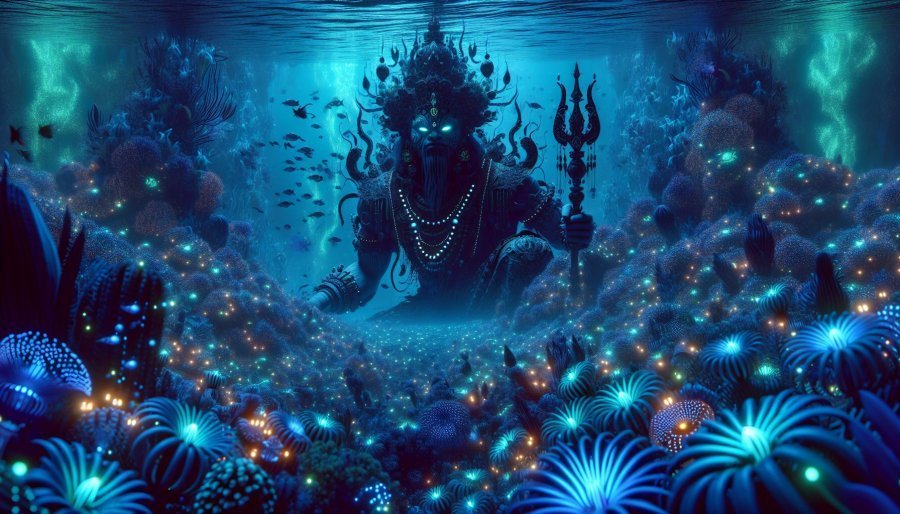Rule for Fierce Cosmic Energies
A sacred journey through divine protection and transformation
Every place resonates with its unique energy, vibrating at frequencies shaped by the discipline, ethics, and protocols upheld within. Urjaa Dham emanates a vibrant aura so profound it transcends mere words; it must be felt to be understood. At its heart, the ‘Garbha-griha’ holds an extraordinary confluence of five powerful cosmic energies essential for human survival and spiritual well-being in the challenging era of ‘Kaliyuga’.
First among these is the energy of Devi Durga, accompanied by her 64 Yoginis. They symbolize the force of life, new beginnings, and transformative ‘Tantras’, a source of primal power that ignites creation and strength. Next stands Kotwal Kaal Bhairava, the fierce guardian of cosmic order, embodying protection at the highest level. His presence ensures balance and enforces divine law without compromise.

The third is Mahakaal, the embodiment of light, time, and the inevitable end of material existence. He reminds devotees of the transient nature of the physical world and the eternal dance of creation and dissolution. Then comes Panchmukhi Hanumana, the five-faced incarnation representing courage, unwavering faith, and penetrating intelligence, the guardian who infuses devotees with strength to overcome inner and outer darkness.
Finally, Shani Deva stands as the divine arbiter of justice and karmic retribution. His energy holds us accountable, balancing actions through cosmic law without favoritism or prejudice.
These five divine energies manifest in their ‘Ugra’ or fierce cosmic forms, vibrating at exceptionally high spiritual frequencies that transcend worldly identity markers such as wealth, status, or reputation. They respond not to external displays but to the silent, conscious feeling within, the intangible essence of true devotion. Offerings made to them serve merely as gestures of gratitude: the law of karma cannot be circumvented by ritual alone
A few steps to your right bring you to the ‘Kotwali’, facing the formidable Kaal Bhairava. Offerings here traditionally include tobacco, black chana (gram), and ‘somrass’, substances symbolizing the groundedness and protection he presides over. Nearby, the 64 Yogini Sthan awaits, where chanting their names invokes blessings. These Yoginis require no special offerings, relying on the grace of their controller, Maa Durga, and their protector, Kaal Bhairav.

Deeper within lies the ‘Prayashchit Kaksh’ to the left, a chamber of atonement and self-purification. To the southeast, the Urjaa Kund holds special significance: a sacred energy pool enshrined with the ‘Navagraha’ (nine planets) and ‘Panch Mahabhut’ (five great elements). Here, offerings called ‘Aahutis’ may be made in honor of the diverse energies housed within Urjaa Dham. However, this chamber remains locked unless a Spiritual Healer, authorized as a cosmic medium, is present.
Before arriving at the ‘Shivalaya’, guests encounter the ‘Akand Deep’, an offering site where mustard oil fuels the eternal flame, symbolizing sustained devotion and illumination. Nearby stands the ‘Trilok Dwar’ at the south of the ‘Garbha-griha’, a cosmic gateway. Before entering ‘Shivalaya’, devotees circumambulate thrice under the sacred ‘Ashwrata’ Peepal tree, reconnecting with nature’s enduring wisdom.
The ‘Shivalya’ lies southwest, home to Shiva and his divine family. Flowers and Gangotri water may be offered, along with Bail Patra, Chandan sticks, Dhatura, Bhang Patra, and milk, especially on Mondays, honoring the multifaceted aspects of Shiva’s power and benevolence.
From here, one moves toward the Panchmukhi Kutir in the northwest, standing before the vigilant Panchmukhi Hanuman. This fierce protector watch over the threshold to Patal, the netherworld, facing south while guarding the ‘Shivalaya’ with grace. Offerings of Black Chana, Ghee, Fruits and Paan are customary, with special offerings of ‘Chola’ on Tuesdays and Saturdays.
Passing through ‘Dharam Pataka’, the path finally arrives at ‘Nayay Darbaar’, the Court of Justice presided over by Shani Deva at the center of the Garbha-griha. Before entering the Shani Darbaar, devotees receive the Hanuman Tilak, a mark invoking courage and protection. Shani is offered black Urad Dal, Mustard oil, Turmeric, Black cloth, and Iron metal. Mustard oil is ceremoniously anointed from foot to head, symbolizing cleansing without direct contact with Shani’s crown. The other offerings rest respectfully in a basket before him.
Remarkably, Urjaa Dham defies conventional norms: it was neither built according to traditional ‘Vastu Shastra’ principles nor influenced by astrological calculations. Instead, the energies themselves chose their dwelling, a cosmic miracle. The temple’s layout and the sacred journey within the Garbha-griha spontaneously manifested from the cosmos, reflecting divine will rather than human design. The path from ‘Shakti Sthal’ to ‘Nayay Darbaar’ was auto-generated by the cosmic order, guiding devotees through an inner spiritual odyssey crafted by universal forces.
This spiritual choreography invites all who enter Urjaa Dham to move beyond external formalities and connect deeply with the unseen energies pulsating at its core. It is a living sanctuary where disciplined adherence and heart-felt consciousness converge, honoring the timeless dance of creation, protection, transformation, and karmic balance that sustains humanity through the trials of ‘Kaliyuga’. .

